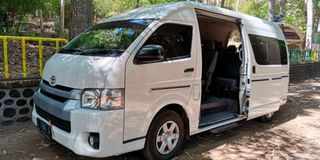I want to start a matatu business, which minibus would you advise me to go for?

Toyota Hiace.
Hi,
Kindly advise which is the better car between the Nissan Vanette and the Toyota Shark. I am torn between the two. I want to start a matatu business.
Regards, Nancy M.
Choosing the right commercial vehicle is a bit like deciding what tree to plant: Look around at what is already growing in the area. Chances are there will be more than one species. Their differences may be minor or major, but those variations do not necessarily make one “better” than the others. Choose whichever your circumstances indicate, but do not choose a species that is not there.
Presuming that the Vanette and the Shark options you refer to are both full-sized minibuses (what ancients like me think of as the Urvan and the Hiace, used as 9-seaters in the tourism industry and 14-seaters in the matatu business) and that is the scale of transport you wish to offer, then you have spotted the two most abundant and successful species. Take your pick.
The original matatu was any vehicle ready to stop and give someone a lift…for a modest fee.
As the industry took more formal shape, the vehicle of choice was a one-ton pick-up with benches on the loadbed (and a couple more passengers on the gear lever!), and tin box on the back for shelter, with a rear door for scrambling in and falling out.
Their NCAP rating for structural safety would have been a big number…preceded by a minus sign.
Some station wagons were also used, but their limited size was a business handicap.
When the minibus emerged as an option (usually as a cast off from the tourist industry) with real seats and a side door, the more dignified travel conditions were the instant preference for passengers and quickly became (and remain) predominant.
And the Nissan Urvan was overwhelmingly the most popular and proven amid a limited choice.
It remained virtually unchallenged for many years because the local assemblers (AVA) had the good sense and the skill to modify it for the treatment it was likely to get (in both the tourism and matatu sectors) particularly the body strength and durability of door mechanisms.
Nissan in Japan adopted some of their ideas. Datsun, which became Nissan over this period, were already well-established as the best-selling brand in Kenya. The Urvan (fore-runner of the Vanette?) was pretty much the only tree in a fast-growing Matatu forest.

Nissan Van.
Toyota, originally represented by Westlands Motors and then Motor Mart, were not seriously in the minibus frame until they were taken over by Lonrho Motors, who captured a progressively big share of both the overall and matatu markets. Extraordinarily, they somehow managed to achieve the unique distinction of being the only national Toyota franchise in the world, ever, to go bankrupt. Toyota Japan took over the reins and has never looked back.
Toyota Kenya are now by far the best-selling brand in both the new and used markets and the Hiace (Shark?) has become the go-to staple for matatus.
Clear business-plan distinction should be drawn between a minibus matatu and the much-increased population of seven-seater “people carriers” such as Voxy and Noah, now predominant in the uber taxi field.
I mention this because one Nissan model also badged “Vanette” is one of these.
‘Look and Listen’ are key mechanical skills
Hello Gavin,
I changed my shocks and stabiliser link but I’m still getting squeaks from the front when going over bumps and on rough roads. What component of the suspension system do I need to change?
Regards, Kevin
Tracking the exact source of squeaks (high-pitched grating noises) can be tricky, even when standing next to the vehicle. But in principle, the cause can be established with some certainty while sitting hundreds of kilometres away reading just three salient words (bumps, suspension, squeaks) on an email.
Suspension squeaks happen when two unlubricated things move/rub against each other. Three options:
If they are supposed to touch and move, then the cure is to lubricate them properly. If they are supposed to touch but not move, then whatever joins them needs to be tightened. If they are not supposed to touch, at least one of them needs to be realigned and securely fastened.
So first, establish exactly which bits are making the noise. Look and Listen while someone simulates bumps by pressing/bouncing the front of the car. Human ears are far from the best in the animal kingdom, but they are still remarkably good at assessing the direction of a sound if there is no obstruction deflecting the noise.
The source could be anything in or under the engine compartment, from a stiffener bar under the plastic bumper that has cracked or come loose to shock-absorber or spring or control arm or body-mounting bushes that have perished.
Those are the most likely culprits. Whatever the finding, new bushes, a spanner or grease are the most likely cures. Buy the best quality bushes you can find or get ready to go through the same process again quite soon.
Do you have a motoring question, email: [email protected]





